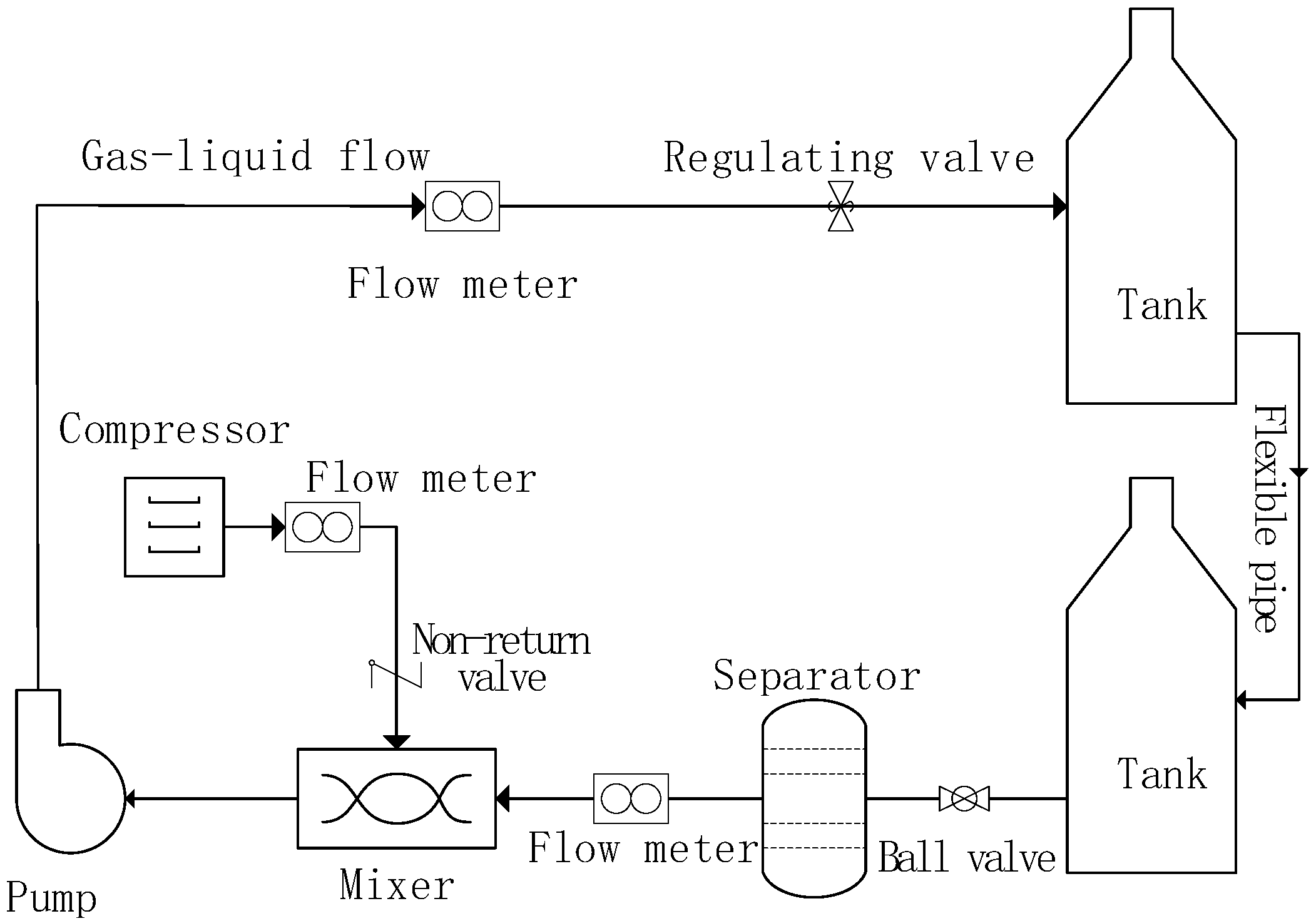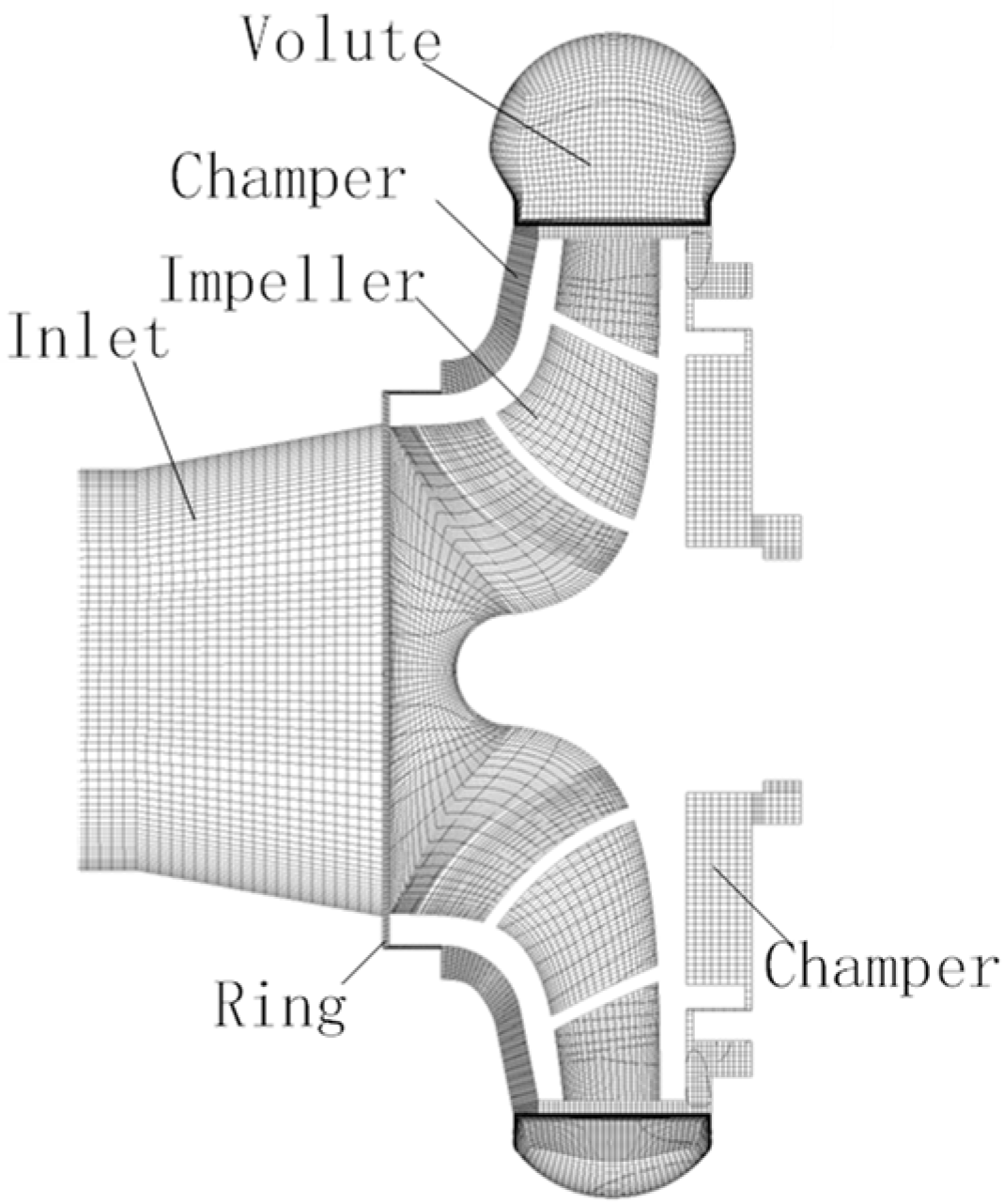Investigation on the Handling Ability of Centrifugal Pumps under Air–Water Two-Phase Inflow: Model and Experimental Validation
Abstract
:1. Introduction
2. Pump Geometry and Experimental Test Rig
3. Numerical Model and Setups
3.1. Model and Mesh
3.2. The Eulerian–Eulerian Inhomogeneous Two-Phase Flow Model
3.3. The Modified Turbulence Model
3.4. Boundary Conditions
4. Overall Pump Performances
5. Influence of Rotational Speed
6. Numerical Results
6.1. Pump Head Deterioration Ratio ψ*: Comparisons between Experiments and One-Dimensional Two-Phase Flow Model
6.2. 3D-URANS Overall Performance Results
6.2.1. Comparison between the Initial and Modified Turbulence Model (See Section 3.3)
6.2.2. 3D-URANS Results Comparison for Different Inlet Void Fraction and Flow Coefficients
6.3. Local Impeller Passage Flow Structures
6.3.1. Flow at Inlet Impeller Section
6.3.2. Flow inside the Impeller Section
7. Conclusions
- Pump performance degradation is more pronounced for low flow rates compared to high flow rates when the inlet void fraction increases. The starting point of a severe pump degradation rate is related to a specific flow coefficient, whose value corresponds to the change of the slope of the theoretical head curve. When increasing the inlet void fraction, the degradation slope curves increase (with a negative sign) with the decreasing flow coefficient. The more the rotational speed decreases, the more the experimental pump performance is affected at a given inlet void fraction value.
- Existing one-dimensional models can be considered quite good tools for the first step of a two-phase flow analysis. They give good global indications based on the mean values along one streamline, but attention should be taken when using non-dimensional flow coefficients. The chosen particle fluid model with interface transfer terms looks quite suitable for evaluating pump performance degradation up to an a value of 7%.
- For a higher a value, CFD can’t always correctly predict the sudden breakdown of the pump performance as obtained by measurements. This is probably due to the flow regime inside the impeller, which does not correspond to a bubbly one anymore. However, for the lowest flow rate, the performance breakdown is well predicted with the modified turbulence model.
- The difference between experimental and numerical results exist not because of rotational speed, but because of its consequence on the local velocity values that decrease according to the flow coefficient, and more specifically at the pump inlet tube and at the pump inlet section. Numerical simulations must take churn flow characteristics into account in order to get better results. Both bubbly and churn flow conditions may be present for inlet flow conditions depending on the experimental setup, rotational speed, and the pump flow coefficient, even at nominal conditions.
- The numerical simulation gives interesting local flow information that would be taken into consideration for new design approaches at the pump inlet section for an improved two-phase flow suction capability of centrifugal pumps.
Author Contributions
Funding
Acknowledgments
Conflicts of Interest
Nomenclature
| a | inlet void fraction |
| b | impeller blade width |
| C | constant pressure value when modified liquid density |
| D | diameter |
| H | pump head |
| n | exponent |
| N | rotational speed |
| p | local pressure |
| P | shaft power |
| Q | volume water flow rate |
| R | radius |
| Re,imp | Impeller Reynolds number |
| t | time |
| th | theoretical |
| tp | related to two-phase condition |
| u | circular velocity |
| v | water cinematic viscosity |
| z | impeller blade |
| Greek symbols | |
| η | global efficiency of the pump η = ρgQH/P |
| ρ | density |
| ρm | density of fluid mixture ρm = ρl (1 − α) + αρg |
| φ | flow coefficient φ = Q/(2π·R2·b2·u2) |
| ψ | head coefficient ψ = gH/(u2)2 |
| Ωs | specific speed |
| ω | angular velocity |
| Subscripts | |
| α | local void fraction |
| B | bubble |
| d | design condition |
| g | gas |
| l | liquid |
| m | mixture fluid |
| ref | reference |
| 0 | related to a = 0 |
| 1 | Impeller pump inlet |
| 2 | Impeller pump outlet |
References
- Gülich, J.F. Centrifugal Pumps; Springer: Berlin/Heidelberg, Germany; New York, NY, USA, 2010; ISBN 978-3-642-12823-3. [Google Scholar]
- Mikielewicz, J.; Wilson, D.G.; Chan, T.C.; Goldfinch, A.L. A method for correlating the characteristics of centrifugal pumps in two-phase flow. J. Fluids Eng. 1978, 100, 395–409. [Google Scholar] [CrossRef]
- Murakami, M.; Minemura, K. Effects of entrained air on the performance of a centrifugal pump First report- Performance and Flow Conditions. Bull. JSME 1974, 17, 1047–1055. [Google Scholar] [CrossRef]
- Minemura, K.; Uchiyama, T.; Shoda, S.; Egashira, K. Prediction of air-water two-phase flow performance of a centrifugal pump based on one-dimensional two-fluid model. J. Fluids Eng. 1998, 120, 237–334. [Google Scholar] [CrossRef]
- Si, Q.R.; Cui, Q.L.; Zhang, K.Y.; Yuan, J.P.; Bois, G. Investigation on centrifugal pump performance degradation under air-water inlet two-phase flow conditions. La Houille Blanche 2018, 3, 41–48. [Google Scholar] [CrossRef]
- Secoguchi, N.; Takada, S.; Kanemori, Y. Study of air-water two-phase centrifugal pump by means of electric resistivity probe technique for void fraction measurement-First report-measurement of void fraction distribution in a radial flow impeller. Bull. JSME 1984, 27, 931–939. [Google Scholar] [CrossRef]
- Estevam, V.; França, F.A.; Alhanati, F.J. Mapping the performance of centrifugal pumps under two-phase conditions. In Proceedings of the 17th International Congress of Mechanical Engineering, Sao Paulo, Brazil, 10–14 November 2003. [Google Scholar]
- Barrios, L.; Prado, M.G. Experimental visualization of two-phase flow inside an electrical submersible pump stage. J. Energy Resour. Technol. 2011, 133. [Google Scholar] [CrossRef]
- Müller, T.; Limbach, P.; Skoda, R. Numerical 3D RANS simulation of gas-liquid flow in a centrifugal pump with an Euler-Euler two-phase model and a dispersed phase distribution. In Proceedings of the 11th European Conference on Turbomachinery, Fuild Dynamics and Thermodynamics, Madrid, Spain, 23–25 March 2015. [Google Scholar]
- Suryawijaya, P.; Kosyna, G. Unsteady measurement of static pressure on the impeller blade surfaces and optical observation on centrifugal pumps under varying liquid/gas two-phase flow condition. J. Comput. Appl. Mech. 2001, 6759, D9–D18. [Google Scholar]
- Si, Q.R.; Bois, G.; Zhang, K.Y.; Yuan, J.P. Air-water two-phase flow experimental and numerical analysis in a centrifugal pump. In Proceedings of the 12th European Conference on Turbomachinery, Fluid Dynamics and Thermodynamics, Stockholm, Sweden, 3–7 April 2017. [Google Scholar]
- Yakhot, V.; Orszag, S.; Thangam, S.; Gatski, T.; Speziale, C. Development of turbulence models for shear flows by a double expansion technique. Phys. Fluids A Fluid Dyn. 1992, 4, 1510–1520. [Google Scholar] [CrossRef] [Green Version]
- Clift, R.; Grace, J.; Weber, M. Bubbles, Drops and Particles; Academic Press: New York, NY, USA, 1978. [Google Scholar]
- Wang, J.; Wang, Y.; Liu, H.; Huang, H.; Jiang, L. An improved turbulence model for predicting unsteady cavitating flows in centrifugal pump. Int. J. Numer. Methods Heat Fluid Flow 2015, 25, 1198–1213. [Google Scholar] [CrossRef]
- Dular, M.; Coutier-Delgosha, O. Numerical modelling of cavitation erosion. Int. J. Numer. Methods Fluids 2009, 61, 1388–1410. [Google Scholar] [CrossRef]
- Coutier-Delgosha, O.; Fortes-Patella, R.; Reboud, J.L. Evaluation of the turbulence model influence on the numerical simulations of unsteady cavitation. ASME J. Fluids Eng. 2003, 125, 38–45. [Google Scholar] [CrossRef]
- Schäfer, T.; Bieberle, A.; Neumann, M.; Hampel, U. Application of gamma-ray computed tomography for the analysis of gas holdup distributions in centrifugal pumps. Flow Meas. Instrum. 2015, 46, 262–267. [Google Scholar] [CrossRef]
- Baker, O. Simultaneous Flow of Oil and Gas. Oil Gas J. 1954, 53, 185–190. [Google Scholar]
- Tomiyama, A.; Kataoka, I.; Sakaguchi, T. Drag coefficients of bubbles. 1st report. drag coefficients of a single bubble in a stagnant liquid. Nihon Kikai Gakkai Ronbunshu B Hen/Trans. Japan Soc. Mech. Eng. Part B 1995, 61, 2357–2364. [Google Scholar]
- Hench, J.E.; Johnston, J.P. Two-dimensional diffuser performance with subsonic, two-phase, air-water flow. ASME J. Basic Eng. 1972, 107, 105–121. [Google Scholar] [CrossRef]
- Zuber, N.; Hench, J.E. Steady State and Transient Void Fraction of Bubbling Systems and Their Operating Limits; General Electric: Schenectady, NY, USA, 1962. [Google Scholar]
- Zhu, J.J.; Zhang, H.Q. A review of experiments and modeling of gas-liquid flow in electrical submersible pumps. Energies 2018, 11, 180. [Google Scholar] [CrossRef]
















© 2018 by the authors. Licensee MDPI, Basel, Switzerland. This article is an open access article distributed under the terms and conditions of the Creative Commons Attribution (CC BY) license (http://creativecommons.org/licenses/by/4.0/).
Share and Cite
Si, Q.; Bois, G.; Jiang, Q.; He, W.; Ali, A.; Yuan, S. Investigation on the Handling Ability of Centrifugal Pumps under Air–Water Two-Phase Inflow: Model and Experimental Validation. Energies 2018, 11, 3048. https://doi.org/10.3390/en11113048
Si Q, Bois G, Jiang Q, He W, Ali A, Yuan S. Investigation on the Handling Ability of Centrifugal Pumps under Air–Water Two-Phase Inflow: Model and Experimental Validation. Energies. 2018; 11(11):3048. https://doi.org/10.3390/en11113048
Chicago/Turabian StyleSi, Qiaorui, Gérard Bois, Qifeng Jiang, Wenting He, Asad Ali, and Shouqi Yuan. 2018. "Investigation on the Handling Ability of Centrifugal Pumps under Air–Water Two-Phase Inflow: Model and Experimental Validation" Energies 11, no. 11: 3048. https://doi.org/10.3390/en11113048




